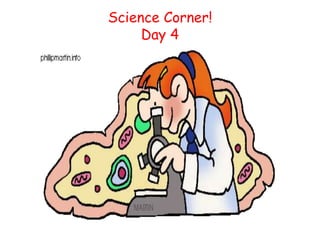Recommended
Recommended
More Related Content
What's hot
What's hot (20)
New discoveries in the field of space ms pp 2010 version

New discoveries in the field of space ms pp 2010 version
Space Pub Quiz #2 - The Contenders Strike Back - Vis Viva - February 12, 2014

Space Pub Quiz #2 - The Contenders Strike Back - Vis Viva - February 12, 2014
Viewers also liked
Viewers also liked (15)
List of services we provide at a2z - Accounting and consulting services 

List of services we provide at a2z - Accounting and consulting services
Similar to Science Week, Day 4
Similar to Science Week, Day 4 (20)
Unit of Inquiry 4: Where We Are in Place and Time: Early Humans

Unit of Inquiry 4: Where We Are in Place and Time: Early Humans
More from PLR3
More from PLR3 (11)
Science Week, Day 4
- 1. Science Corner! Day 4
- 2. Scientist of the Day Jane Goodall
- 3. Jane Goodall is a British scientist who has spent her life finding out how chimpanzees and apes survive in the wild. As Goodall studies apes and chimpanzees, she is called a primatologist – ‘primas’ is the latin for first. Monkeys, chimpanzees and apes are all called ‘primates’ as evolutionary theory suggests that monkeys are the ’first’ step in human evolution.
- 4. In July 1960, at the age of 26, Jane Goodall traveled from England to what is today Tanzania and bravely entered the little-known world of wild chimpanzees. She was equipped with nothing more than a notebook and a pair of binoculars. She managed to become a member of a chimpanzee family or ‘troop’ by being kind, and respectful of the ways of the chimpanzee.
- 5. During her research, Jane discovered three very important things: • Chimpanzees could make tools for grooming and scavenging from twigs. • Chimpanzees communicated feelings through hugs, kisses, slaps and punches. • Chimpanzees worked as a group to solve problems. These findings were amazing to scientists as they believed that only humans could act like thi.
- 8. Space Facts • Footprints and tyre tracks left behind by astronauts on the moon will stay there forever as there is no wind to blow them away. • Jupiter's 4 biggest moons are named Europa, Ganymede, Callisto and Io. • Halley’s Comet was last seen in the inner Solar System in 1986, it will be visible again from Earth sometime in 2061 (get your camera ready). • Because of lower gravity, a person who weighs 100kg on earth would only weigh 38kg on the surface of Mars. • The first man made object sent into space was in 1957 when the Russian satellite named Sputnik was launched. • The first animal in space was a Russian dog named Laika.
- 10. Science Picture of the Day
- 11. Say hello to the ‘Deepsea Challenger’! On March 26th 2012, James Cameron (the man who directed Titanic) navigated this submarine down to the bottom of the Marianas Trench, the deepest place on Earth hidden under a huge volume of water. This had not been done since 1960. It took Cameron over 70 minutes to travel the 7 miles down to the bottom of Earth to take videos and to collect scientific data of the plant and animal life that live in this deep and dark place.
